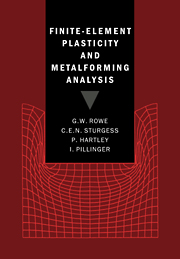Book contents
- Frontmatter
- Contents
- Preface
- Acknowledgements
- Nomenclature
- 1 General introduction to the finite-element method
- 2 Basic formulation for elastic deformation
- 3 Small-deformation elastic–plastic analysis
- 4 Finite-element plasticity on microcomputers
- 5 Finite-strain formulation for metalforming analysis
- 6 Implementation of the finite-strain formulation
- 7 Practical applications
- 8 Future developments
- Appendix 1 Derivation of small-strain [B] matrix for 2-D triangular element
- Appendix 2 Derivation of elastic [D] matrix
- Appendix 3 Derivation of elastic–plastic [D] matrix
- Appendix 4 Derivation of small-strain stiffness matrix [K] for plane-stress triangular element
- Appendix 5 Solution of stiffness equations by Gaussian elimination and back-substitution
- Appendix 6 Imposition of boundary conditions
- Appendix 7 Relationship between elastic moduli E, G and κ
- Appendix 8 Vectors and tensors
- Appendix 9 Stress in a deforming body
- Appendix 10 Stress rates
- Appendix 11 Listing of BASIC program for small-deformation elastic–plastic FE analysis
- Bibliography
- Index
4 - Finite-element plasticity on microcomputers
Published online by Cambridge University Press: 22 September 2009
- Frontmatter
- Contents
- Preface
- Acknowledgements
- Nomenclature
- 1 General introduction to the finite-element method
- 2 Basic formulation for elastic deformation
- 3 Small-deformation elastic–plastic analysis
- 4 Finite-element plasticity on microcomputers
- 5 Finite-strain formulation for metalforming analysis
- 6 Implementation of the finite-strain formulation
- 7 Practical applications
- 8 Future developments
- Appendix 1 Derivation of small-strain [B] matrix for 2-D triangular element
- Appendix 2 Derivation of elastic [D] matrix
- Appendix 3 Derivation of elastic–plastic [D] matrix
- Appendix 4 Derivation of small-strain stiffness matrix [K] for plane-stress triangular element
- Appendix 5 Solution of stiffness equations by Gaussian elimination and back-substitution
- Appendix 6 Imposition of boundary conditions
- Appendix 7 Relationship between elastic moduli E, G and κ
- Appendix 8 Vectors and tensors
- Appendix 9 Stress in a deforming body
- Appendix 10 Stress rates
- Appendix 11 Listing of BASIC program for small-deformation elastic–plastic FE analysis
- Bibliography
- Index
Summary
MICROCOMPUTERS IN ENGINEERING
The previous chapters of this book have focussed attention on the basic FE theory for elastic and small-deformation elastic-plastic applications. The latter were illustrated by a very simple analysis of the tensile test.
In this chapter, we shall look at problems more closely associated with realistic metalforming processes. The first part of the chapter examines a PC-program written in BASIC that can be used for demonstrations or for student tutoring. A listing of this program is given in Appendix 11.
The second part of the chapter describes a FORTRAN program, implemented on a large-memory micro, that is designed for more serious metalforming studies.
No attention has been given so far to the machines on which FE analyses can be performed. Where mainframe computers or workstations are available, this is not important but in microcomputer applications, how the machine operates and the importance of selecting the right operating system, software and processors cannot be taken for granted. The decision as to what equipment is most appropriate must be made by the individual user, based on carefully assessed requirements.
A general introduction to microcomputers is given by Avison [4.1] in which many aspects of micro hardware and software are discussed, and comment on buying a micro is included.
- Type
- Chapter
- Information
- Finite-Element Plasticity and Metalforming Analysis , pp. 49 - 65Publisher: Cambridge University PressPrint publication year: 1991

